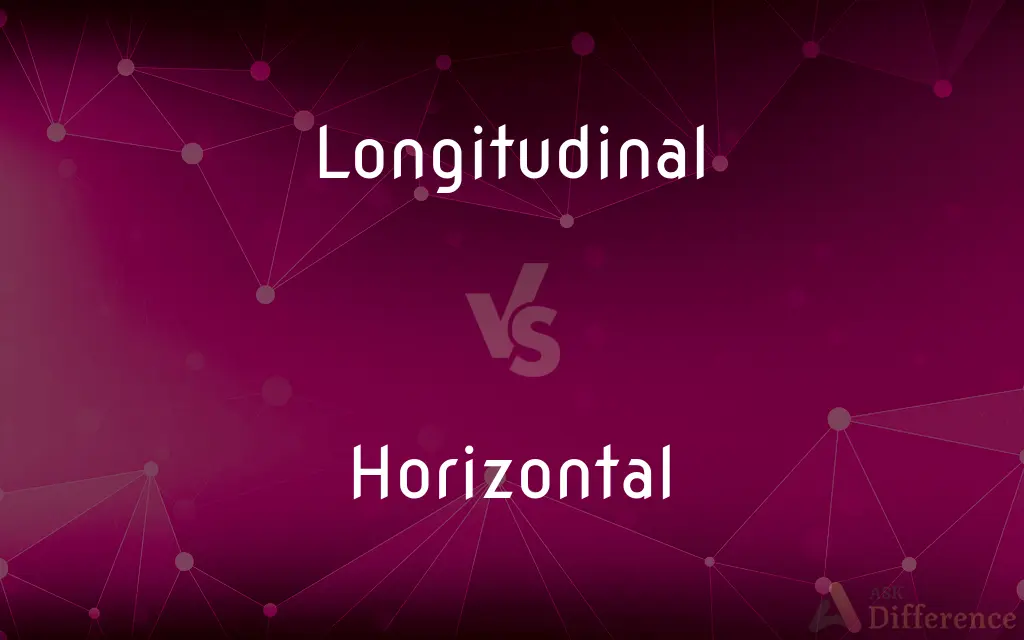Longitudinal vs. Horizontal — What's the Difference?
Edited by Tayyaba Rehman — By Fiza Rafique — Updated on April 9, 2024
Longitudinal refers to alignment along the longest axis, often related to direction or length, while horizontal signifies alignment parallel to the horizon or ground.

Difference Between Longitudinal and Horizontal
Table of Contents
ADVERTISEMENT
Key Differences
Longitudinal orientation involves the alignment or extension along the longest dimension of an object or point of reference, often implying a direction along the length from end to end. For example, longitudinal studies track changes over time, emphasizing the dimension of duration and development. On the other hand, horizontal alignment or orientation runs parallel to the horizon or ground level, implying a side-to-side direction that spans across a plane perpendicular to the force of gravity. This orientation is crucial in fields like geography and construction, where understanding the horizontal plane is essential for mapping and building structures.
In scientific research, a longitudinal approach is adopted to observe changes within the same subjects over a prolonged period, allowing for the examination of developmental trends and cause-effect relationships. Whereas, horizontal comparisons typically involve analyzing data across a wide spectrum at a single point in time, offering insights into diversity and breadth of characteristics within a population or phenomenon.
From a geographical perspective, longitudinal lines, or meridians, run from the North to the South Pole, measuring distances east or west of the Prime Meridian. These lines are critical for navigation and timekeeping. In contrast, horizontal lines on a map, such as latitude lines, run east-west and measure distances north or south of the Equator, playing a key role in climate zones and geographical positioning.
In architecture and engineering, the concept of longitudinal strength speaks to the robustness of a structure along its length, crucial for withstanding stresses such as compression and tension over long spans. Horizontal strength, however, refers to the ability of a structure to bear loads and resist forces that act perpendicular to its vertical axis, essential for stability and load distribution.
In terms of data visualization, longitudinal graphs display changes over time, showing how variables evolve along a temporal axis. Horizontal graphs or charts, like bar charts, often compare different entities across a horizontal axis to highlight variations or similarities in value, providing a snapshot of data at a specific moment.
ADVERTISEMENT
Comparison Chart
Alignment
Along the longest axis or length
Parallel to the horizon or ground
Purpose
Emphasizes changes over time or length
Highlights variations across a plane
Use in Research
Tracks developments within subjects over time
Compares different subjects at one time
Geographical Relevance
Related to meridians (longitudes)
Pertains to latitudes (horizontal lines)
Significance in Construction
Concerns strength along an object’s length
Involves stability and load distribution across a plane
Compare with Definitions
Longitudinal
Pertaining to longitudinal lines on the globe.
Longitudinal coordinates help in navigation.
Horizontal
Parallel to the ground or horizon.
The horizontal shelf was perfectly leveled.
Longitudinal
Focused on development or change over time.
Longitudinal data revealed significant trends.
Horizontal
Involving comparisons or measurements across a plane.
Horizontal analysis compares financial data across years.
Longitudinal
Involving comparison or measurement along the length.
Longitudinal stress tests measure durability.
Horizontal
Pertaining to horizontal stratification in society.
Horizontal mobility reflects changes within one’s class.
Longitudinal
Relating to the lengthwise direction.
The longitudinal study spanned two decades.
Horizontal
Spanning side to side in a flat plane.
The horizontal expansion of the city was rapid.
Longitudinal
Running along the major axis of a body.
The car’s longitudinal axis improves aerodynamics.
Horizontal
Lying flat or even.
Horizontal lines on the paper guided my writing.
Longitudinal
Of or relating to longitude or length
A longitudinal reckoning by the navigator.
Made longitudinal measurements of the hull.
Horizontal
Of, relating to, or near the horizon.
Longitudinal
Concerned with the development of persons or groups over time
A longitudinal study of twins.
Horizontal
Parallel to or in the plane of the horizon.
Longitudinal
Placed or running lengthwise
Longitudinal stripes.
Horizontal
At right angles to a vertical line.
Longitudinal
Relating to length, or to longitude.
Horizontal
Occupying or restricted to the same level in a hierarchy
A horizontal study of verbal ability.
A horizontal transfer by an employee.
Longitudinal
Running in the direction of the long axis of a body.
Horizontal
(Medicine) Of or relating to transmission of infection by contact with or physical proximity to an infected individual or fomite.
Longitudinal
Forward and/or backward, relative to some defined direction.
Horizontal
Something, such as a line, plane, or object, that is horizontal.
Longitudinal
Sampling data over time rather than merely once.
Longitudinal studies
Horizontal
Perpendicular to the vertical; parallel to the plane of the horizon; level, flat.
Horizontal lines
Longitudinal
Any longitudinal piece, as in shipbuilding etc.
Horizontal
(marketing) Relating to horizontal markets
Longitudinal
(rail transport) A railway sleeper lying parallel with the rail.
Horizontal
(archaic) Pertaining to the horizon.
Longitudinal
Of or pertaining to longitude or length; as, longitudinal distance.
Horizontal
(wine) Involving wines of the same vintages but from different wineries.
Longitudinal
Extending in length; in the direction of the length; running lengthwise, as distinguished from transverse; as, the longitudinal diameter of a body.
Horizontal
Having the two notes sound successively.
Longitudinal
A railway sleeper lying parallel with the rail.
Horizontal
A horizontal component of a structure.
Longitudinal
Of or relating to lines of longitude;
Longitudinal reckoning by the navigator
Horizontal
(geology) Horizon.
Longitudinal
Running lengthwise;
A thin longitudinal strip
Longitudinal measurements of the hull
Horizontal
A Tasmanian shrub or small tree whose main trunk tends to lean over and grow horizontally, Anodopetalum biglandulosum
Longitudinal
Over an extended time;
A longitudinal study of twins
Horizontal
Pertaining to, or near, the horizon.
Horizontal
Parallel to the horizon; on a level; as, a horizontalline or surface.
Horizontal
Measured or contained in a plane of the horizon; as, horizontal distance.
Horizontal
Something that is oriented horizontally
Horizontal
Parallel to or in the plane of the horizon or a base line;
A horizontal surface
A vertical camera angle
The monument consists of two vertical pillars supporting a horizontal slab
Measure the perpendicular height
Common Curiosities
Why are longitudinal studies important?
They are crucial for understanding how subjects change over time, revealing trends and cause-effect relationships.
What is an example of horizontal expansion?
The outward spread of a city or development across the landscape is an example of horizontal expansion.
How does horizontal orientation differ from vertical?
Horizontal orientation runs parallel to the ground, whereas vertical stands perpendicular to it.
What does horizontal strength in construction imply?
It implies the ability of a structure to bear lateral loads and distribute forces across its horizontal plane.
What is the significance of horizontal lines in geography?
Horizontal lines, or latitudes, are significant for defining climate zones and geographical positioning.
What is longitudinal alignment?
Longitudinal alignment refers to the arrangement or direction along the longest dimension of an object or entity.
How do longitudinal lines help in navigation?
They enable accurate positioning and navigation by measuring distances east or west of the Prime Meridian.
In what context might longitudinal data be analyzed?
Longitudinal data is often analyzed in research to study changes in populations or phenomena over time.
Can a study be both longitudinal and horizontal?
Yes, a study can incorporate both approaches by tracking changes over time (longitudinal) across different groups (horizontal).
What role do horizontal structures play in architecture?
They contribute to the stability and aesthetic of buildings by defining floors and supporting load distribution.
How do longitudinal and horizontal approaches complement each other in studies?
Together, they offer a comprehensive view of how variables change over time (longitudinal) and across different groups or conditions (horizontal).
Can horizontal orientation affect data visualization?
Yes, the orientation can impact how data is interpreted, with horizontal layouts often used for comparisons.
How do horizontal and vertical analyses differ in finance?
Horizontal analysis compares account balances and ratios over different periods, while vertical analysis looks at each item as a percentage of a base figure within a single period.
What challenges come with longitudinal research?
Challenges include maintaining participant engagement over time and accounting for external variables.
Why might a geographer focus on horizontal distribution?
To study the spread and interaction of phenomena across different regions at a given time.
Share Your Discovery

Previous Comparison
Rescind vs. Withdraw
Next Comparison
Sentiment vs. SensationAuthor Spotlight
Written by
Fiza RafiqueFiza Rafique is a skilled content writer at AskDifference.com, where she meticulously refines and enhances written pieces. Drawing from her vast editorial expertise, Fiza ensures clarity, accuracy, and precision in every article. Passionate about language, she continually seeks to elevate the quality of content for readers worldwide.
Edited by
Tayyaba RehmanTayyaba Rehman is a distinguished writer, currently serving as a primary contributor to askdifference.com. As a researcher in semantics and etymology, Tayyaba's passion for the complexity of languages and their distinctions has found a perfect home on the platform. Tayyaba delves into the intricacies of language, distinguishing between commonly confused words and phrases, thereby providing clarity for readers worldwide.
















































